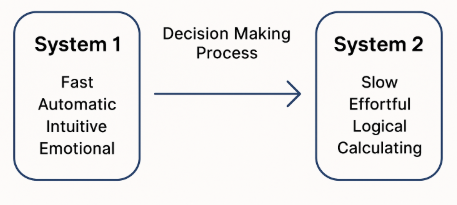A Dual-System Perspective
Decision-making
is a fundamental psychological process, central to human behavior. Over the
years, psychologists and cognitive scientists have sought to understand how
individuals make choices, weigh options, and sometimes, make mistakes. A
particularly influential framework for understanding decision-making is the dual-system
theory, often associated with the work of Daniel Kahneman and Amos Tversky.
According to this model, two distinct cognitive systems govern human thought: System
1 and System 2.
System 1: The Intuitive Executor
System 1 is characterized by its speed,
automaticity, and emotional grounding. It operates without voluntary control,
drawing on intuition, experience, and emotion to produce quick judgments.
Everyday decisions—such as recognizing a familiar face, responding to a
friend's tone of voice, or driving a well-known route—are dominated by System 1
processing.
Because it
relies heavily on heuristics (mental shortcuts), System 1 enables humans
to navigate complex environments efficiently. However, this reliance can also
make us susceptible to cognitive biases such as confirmation bias,
availability bias, or stereotyping. For instance, if a person once had a
negative experience with a particular dog breed, System 1 might
automatically trigger fear whenever encountering that breed, regardless of the
individual dog's behavior.
System 1 is
indispensable for survival. Its rapid judgments were evolutionarily
advantageous, enabling early humans to react instantly to threats without the
delay of logical deliberation. Even in the modern world, System 1 helps us make
countless daily decisions without overwhelming our mental resources.
System 2: The Rational Deliberator
In contrast,
System 2 represents the slower, more deliberate, and logical mode of
thought. It activates when tasks demand concentration, reasoning, and
analysis—such as solving a complex math problem, planning a detailed project,
or critically evaluating a political argument.
System 2
thinking requires effort, and as such, it is resource-intensive.
Engaging System 2 can lead to more accurate, rational outcomes, but because it
consumes cognitive energy, humans often avoid activating it unless absolutely
necessary. Moreover, System 2 can be "lazy": it frequently accepts
the intuitive judgments of System 1 unless specifically prompted to question or
reassess them.
For example,
when someone first encounters a news article that aligns with their beliefs
(System 1’s domain), they might accept it uncritically. However, if they engage
System 2, they might scrutinize the evidence, recognize potential bias, and
form a more nuanced understanding.
System 2
also serves a monitoring function. It can override automatic responses
when they are inappropriate, such as when resisting an impulsive reaction in
favor of a measured response. However, its effectiveness depends on factors
like motivation, cognitive capacity, stress, and fatigue.
The Interaction Between Systems
While often
portrayed separately, System 1 and System 2 continuously interact.
System 1 generates impressions, feelings, and intuitions. System 2 may endorse
these intuitions or question them, leading to revision or suppression. In many
cases, we live comfortably with System 1’s outputs. Yet when faced with
unfamiliar, high-stakes, or conflicting situations, System 2 is summoned to
perform a more thorough analysis.
This dynamic
interplay explains many paradoxes in human behavior. For example, a person
might impulsively buy an expensive item (System 1) and later rationalize the
purchase with elaborate justifications (System 2), even if the initial decision
was purely emotional.
Implications for Daily Life
Understanding
the distinction between System 1 and System 2 has profound implications:
- Awareness of Bias: Recognizing when System 1 is
at work can help individuals become more mindful of biases and strive for
more reflective thinking.
- Improving Decision Quality: Knowing when to deliberately
engage System 2 can lead to better decisions, particularly in important or
complex situations.
- Stress Management: Under stress, System 2
capacity diminishes, and we revert more strongly to System 1. Managing
stress can thus help maintain rational decision-making abilities.
- Education and Training: Techniques that foster
critical thinking and metacognition can strengthen System 2 activation and
monitoring skills.
Conclusion
The
dual-system framework offers a compelling lens through which to understand
human decision-making. System 1 provides speed and efficiency but at the
risk of bias and error. System 2 offers logic and thoroughness but
demands effort and vigilance. A wise decision-maker is not one who relies
solely on one system but rather one who understands when to trust intuition and
when to slow down for thoughtful analysis. Balancing these systems is essential
for navigating the complexities of the modern world with both agility and
wisdom.


Comments
Post a Comment